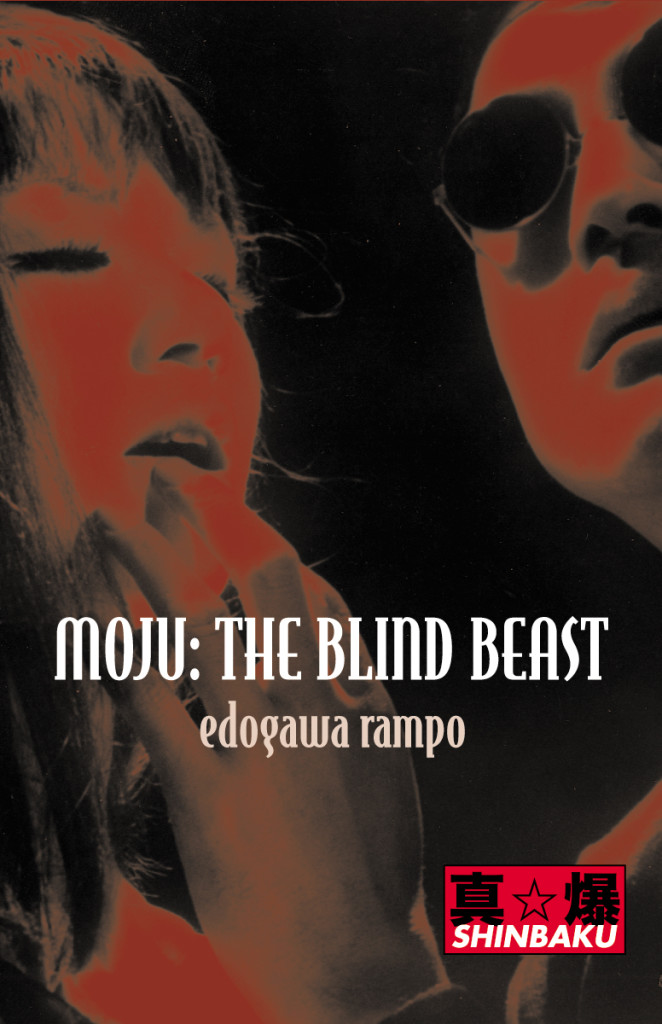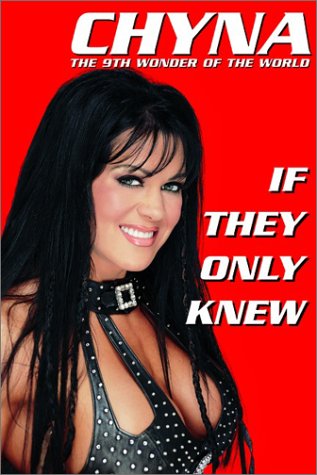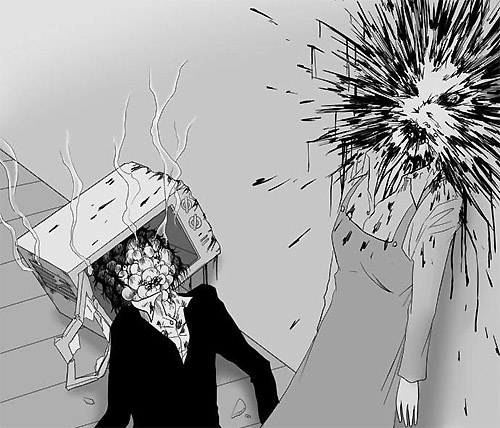 In 1925 Edogawa Rampo wrote one of Japan’s creepiest horror stories. “The Human Chair” was the literary equivalent of pleasantries from the mouth of an leering pervert – the events were tame, even funny at the end, but its subtext of sickness and depravity made it hard to forget.
In 1925 Edogawa Rampo wrote one of Japan’s creepiest horror stories. “The Human Chair” was the literary equivalent of pleasantries from the mouth of an leering pervert – the events were tame, even funny at the end, but its subtext of sickness and depravity made it hard to forget.
Moju: The Blind Beast recreates the same atmosphere, but now that subtext is matched with violent and gruesome events more in line with the Hollywood slasher movies it predates by forty years. It has moments of humour, as well as amusing Japanese political incorrectness (Hawaiians are described as “barbarous”, Westerners in general are “disgusting”), but the main impression The Blind Beast leaves is one of destruction and carnage, blood spraying the walls like an artistic fresco.
Singer Mizuki Ranko is being stalked by an blind man of artistic bent who is obsessed with touching the curves and contours of her body. Soon, she finds herself imprisoned in his underground maze, which has walls fitted out with rubber breasts and noses and legs. The man has an obsession with touching things, and craves the stimulus he cannot get from his eyes. He has chosen Ranko to fulfill his desires, and she still might not be enough.
I liked “The Human Chair” more, mostly because it’s more compact and focused, but The Blind Beast is an entertaining read and touches upon many similar themes. Rampo obviously wants to be more sexually explicit, but for whatever reason (fears of censorship or his own prudishness) he tends to imply or insinuate sex rather than outright state it. The effect is rather brilliant, and probably more disturbing for the fact that it isn’t explicit. I’m reminded of how Hollywood’s Golden Age occurred during the period when it laboured under the infamous Production Code.
The book has things to say about art – again, through allegory and inference. The book ends with the blind man conducting an art exhibit, showing a sculpture made from the pieces of various murder victims. A not-so-nice feature, but artists are often not-so-nice people.
The truth is, if The Blind Beast‘s artist goes to hell for his crimes, he might have to wait in line. John Lennon liked to tune up on his wife. So did Elvis Presley. William S Burroughs shot his wife in a drunken game. Allen Ginsberg is a member of NAMBLA. All these guys were members of the vaunted 50s/60s counterculture, back when people thought that art would be the force that saves us from the evil capitalists and what not. A nice idea, but maybe Rampo was right.
Maybe artists, deep down, are the worst people of all.
 Chyna’s autobiography is part of one of publishing’s more inexplicable trends: the sudden rush of pro-wrestling tell-all books. In the late 90s it seemed that everyone who stepped inside the WWF offices short of the pizza delivery guy was suddenly writing a book about it. The Rock published an autobiography…in 2000. Imagine that, writing your autobiography when you’re 27. It’s like if Steven Spielberg wrote his career retrospective after making Jaws in 1975.
Chyna’s autobiography is part of one of publishing’s more inexplicable trends: the sudden rush of pro-wrestling tell-all books. In the late 90s it seemed that everyone who stepped inside the WWF offices short of the pizza delivery guy was suddenly writing a book about it. The Rock published an autobiography…in 2000. Imagine that, writing your autobiography when you’re 27. It’s like if Steven Spielberg wrote his career retrospective after making Jaws in 1975.
As a general rule, wrestlers should not write tell-all books unless they’re about five years removed from the sport (and McMahon’s chequebook). Otherwise, you get weak, not-very-shocking accounts by people who promise to spill the beans and dish the dirt…but not all the beans, and not very much of the dirt. They’ve got to stay in the WWF/WWE’s good books because, hey, McMahon still might call and offer them another payday.
Chyna breaks the rule, with this book being written just one year after winning the WWF Intercontinental Championship, but it’s fairly interesting as these books go. We learn about her early life, beauty pageants, various odd jobs, how she got discovered, her quest to find breast implants that won’t rupture in the ring, and her shitty dad. If you want bitterness and bad-mouthing, there’s a lot of it here. If you listen closely, you can hear the sound of a hundred bridges burning. Wrestlers are usually all too willing to sling mud at each other, just so long as they don’t insult the federation.
There’s lots of photos, and some stories contributed by Triple H and Mick Foley. Mostly the book hits all the expected spots for a sports tell-all book, and it’s (ghost)written well. This is coming from someone who’s not a super huge fan of pro wrestling. I follow it like I follow the UFC – that is, I only follow the freaks and the misfits. It’s a credit to this book that it remains accessible to someone like me, sitting in the cheap seats.
It has one big weakness, and it’s the same thing you could say about Dwayne Johnson’s book – it came too soon. Obviously there was a cash cow to milk, but what would this book have looked like if it was published 10 years later? It would cover the termination of her contract, her sex tape, her substance abuse problems, her adult entertainment career – a story or two there, no? But that’s getting a bit too sordid, and the book would end on a depressing note. It is difficult to sell a story about female empowerment when your latest industry accomplishment is a movie called Backdoor to Chyna.
But if you want to get picky, Chyna’s porn career officially started with Chyna Fitness in 2000, which has Chyna doing circuit training while the camera zooms in on her cleavage. Towards the end I became convinced that it was a porn video masquerading as a workout tape, and my view hasn’t changed since then. Seriously, if you have a market of muscle fetishists to exploit and you don’t want to look too obviously sleazy, what do you do? It’s like Japan’s “Soaplands”, where women oil you up and molest you, and the business skirts legal arbitration by claiming it’s a massage parlour.
 This comic is a series of 4-10 page shorts, re-telling Brothers Grimm and Hans Christian Andersen fairytales with disturbing guro violence. I was surprised to learn which side of the Sea of Japan it comes from. China has never been known for grotesque horror and transgression – their art normally seeks edification and austerity.
This comic is a series of 4-10 page shorts, re-telling Brothers Grimm and Hans Christian Andersen fairytales with disturbing guro violence. I was surprised to learn which side of the Sea of Japan it comes from. China has never been known for grotesque horror and transgression – their art normally seeks edification and austerity.
I haven’t read the full thing and I probably never will, because the group scanlating this thing abandoned it. But I’ve seen enough to know what it’s like, and I highly recommend it to environmentalists on the grounds that 99% of it is recycled. Junji Ito’s one-shot manga get copied a lot. “Christmas Special” features dead bodies hanging from Christmas trees, like in “Army of One”. “Golden Girl” repeats “Glyceride’s” pus-squeezing gross-out. “Doll’s Funeral” abandons any attempt at skirting plagiarism and just redraws “Hell Doll’s Funeral” panel for panel.
Shintaro Kago is another obvious “influence”, particularly his fussy art style and slapstick black comedy. Pretty sure having your body becoming filled with insects is a central idea to one of his comics but I couldn’t give you a name. Dare I say it, but there’s some Suehiro Maruo in this series too, especially the outrageous tearjerker “Waiting”, which takes Bambi-esque emotional manipulation and all but makes it into a science.
DaShu Jiang uses the artistic five finger discount more than she should, but the comic isn’t bad. She seems to have a Ito/Ballard-esque talent for turning a sow’s ear into a silk purse, and making the familiar seem striking and new. Some of the art in the stories is really good, and often the ideas are good enough to match. “Growing Old” features a baby growing to adulthood then dotage…and then beyond. A fine example of how to tell a quirky and interesting story in eight pages.
It’s not straight horror like Ito, and the camp factor is pretty high (“Little Red Riding Hood” features the little girl slashing the wolf’s stomach open to get her grandmother back, and then selling the wolf’s fur coat). The comic is sprinkled with lots of anime cheese, and the result is odd and pleasant – violent kawaii?
It’s hard to go wrong with this sort of thing. The comics are so short and so satisfying that it isn’t hard to read another one, then another, and then you’re fifty pages in. The formula is obvious, but the comics still pack an effective shock – strangely, predictability doesn’t really hurt Collapse. You get to enjoy the buildup to the final panel, even though you often have a fair idea of what’s coming. Someone once said that limericks are not funny because they end with a dirty word but because they cannot end with anything but a dirty word, and the same principle holds true here.
As far as I know this series is still going on. It’s odd, and doesn’t fit really well into a category, but it’s worth checking out if you like Ito and so forth. Or you can check out the half that’s been translated, at least. The world may be collapsing but one thing will never change: scanlation groups will continue to be run by unstable lunatics.
 In 1925 Edogawa Rampo wrote one of Japan’s creepiest horror stories. “The Human Chair” was the literary equivalent of pleasantries from the mouth of an leering pervert – the events were tame, even funny at the end, but its subtext of sickness and depravity made it hard to forget.
In 1925 Edogawa Rampo wrote one of Japan’s creepiest horror stories. “The Human Chair” was the literary equivalent of pleasantries from the mouth of an leering pervert – the events were tame, even funny at the end, but its subtext of sickness and depravity made it hard to forget.

